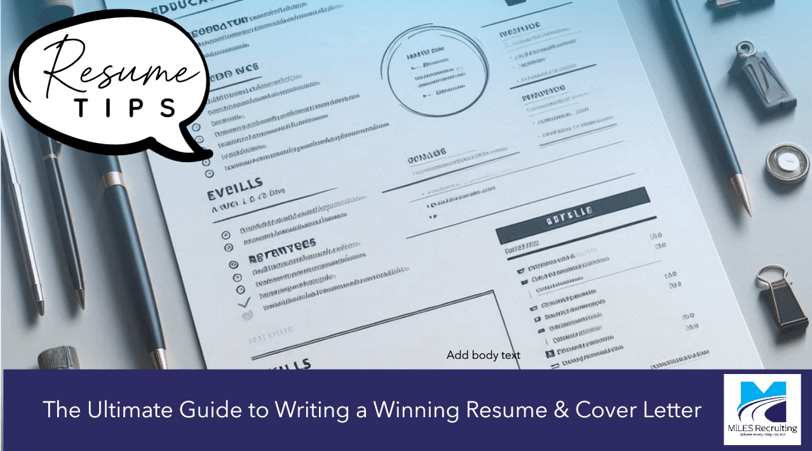The Ultimate Guide to Writing a Winning Resume & Cover Letter


In today's competitive job market a well-crafted resume and cover letter can make all the difference in landing your dream job. These two documents are often your first impression for a potential employer. Whether you're just starting your career or looking for a new opportunity, tailoring your resume and cover letter to each job is crucial to showcasing your qualifications and standing out. This article will provide expert tips on creating a winning resume and cover letter that highlight your skills to grab the attention of hiring managers and increase your chances of success.
Resume Tips:
Tailor to the Job - customize your resume for each application by focusing on the experience, skills, and keywords from the job description. This shows employers that you’re the perfect fit for the role.
Keep It Concise - limit your resume to 1-2 pages, emphasizing your most relevant experiences and achievements. Use bullet points (5-10 per section) to maintain clarity and make your resume easy to scan.
Include a Strong Summary - begin with a compelling summary or objective statement that highlights your core competencies and aligns with the role you are applying for. Showcase how your background and skills directly relate to the position.
Focus on the Last 15 Years - include only your most recent 10-15 years of experience unless earlier roles are highly relevant to the job. This keeps your resume focused and ensures employers see the most applicable parts of your career.
Quantify Achievements -wherever possible, use numbers to illustrate your impact. Phrases like “Increased revenue by 20%” or “Led a team of 10” give hiring managers concrete evidence of your contributions.
Use Action Verbs -start each bullet point with a powerful action verb such as “led,” “developed,” “managed,” or “implemented.” This demonstrates your initiative and emphasizes your achievements.
Relevant Skills - highlight key skills that align with the job you're applying for. Incorporate industry-specific terms and technical skills to help your resume pass Applicant Tracking Systems (ATS).
Maintain Consistent Formatting - ensure uniform formatting for headings, bullet points, and text alignment. Proofread thoroughly—any spelling or grammatical mistakes can leave a negative impression, so aim for a flawless presentation.
Cover Letter Tips:
Your cover letter is your opportunity to capture the attention of the recruiter and highlight your qualifications to show what sets you apart from other applicants. Here's how to craft a winning one:
Personalize It - whenever possible address the cover letter to a specific person rather than using a generic greeting like "To Whom It May Concern." Research the hiring manager’s name to make your letter more personal and engaging.
Start with a Strong Opening - grab attention from the start by beginning with a brief introduction, mentioning the role you’re applying for, how you found it, and why you’re excited about the opportunity.
Tailor to the Job - just like your resume, customize your cover letter for each job. Show that you understand the company’s needs and how your unique skills and experience make you the right fit.
Showcase Your Value - highlight your most relevant skills and accomplishments that align with the job requirements. Use specific examples from your past roles to demonstrate how your contributions can benefit the company.
Address Gaps or Transitions - ff your resume includes gaps or transitions (such as a career change or break), briefly address them in your cover letter. Reassure the employer and explain how your past experiences still align with the role.
Be Concise - keep your cover letter to one page and focus on the most important points. Make sure every sentence adds value and supports your application.
Use Keywords - incorporate keywords from the job description to demonstrate that you meet the required qualifications. This is crucial for ensuring your application passes through applicant tracking systems (ATS).
End with a Call to Action - close your cover letter on a confident note. Express enthusiasm about the role and ask for the opportunity to discuss your application further. A strong call to action—such as requesting an interview—adds impact.
Proofread Thoroughly - just like your resume, errors in your cover letter can leave a bad impression. Double-check for spelling, grammar, and formatting mistakes to ensure your letter is polished and professional.
Your cover letter should complement your resume by expanding on your qualifications and showing genuine enthusiasm for the role.
Crafting a winning resume and cover letter is not just about listing your qualifications; it’s about presenting your experience and skills in a way that aligns with the employer’s needs. By tailoring each document to the specific job, using strong action verbs, quantifying your achievements, and ensuring a polished, error-free presentation, you’ll give yourself the best chance of standing out in a competitive market. Remember, these documents are your first step toward securing that interview, so take the time to perfect them. With the right approach, you’ll be well on your way to landing your next career opportunity.
At MiLES Recruiting we specialize in connecting top-tier talent with leading companies in the manufacturing and automotive industries. Whether you’re looking for skilled trades professionals, engineers, or industry experts, we find the right fit to drive your business forward.
Ready to hire exceptional talent or explore new career opportunities?
Call us today @ 269.221.3486 or
visit us online at www.milesrecruiting.com to get started!
Your Success Begins with the Right Talent. Let’s Make It Happen.
Reach out to us!
info@milesrecruiting.com
Subscribe to our monthly newsletter:
View our Privacy Policy Here
